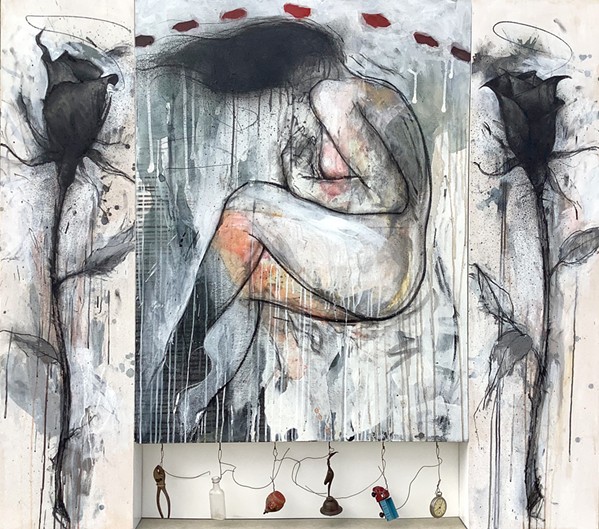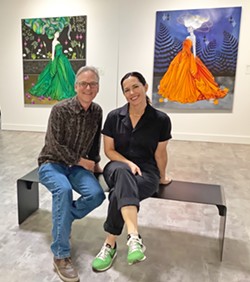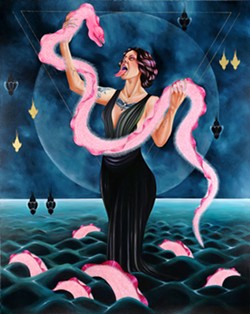Three years ago, artists David Limrite and Lena Rushing began discussing the possibility of mounting a show together. It wasn't that they shared the same style or technique. Limrite works primarily in graphite, charcoal, acrylic, and collage "to create mysterious, dramatic, energetic, dark, and edgy mixed-media figurative work," according to his statement. Rushing's work "typically features a strong, unconventional female presence and relies heavily on symbolism."
What they do have in common is the use of the female form to communicate their ideas. And according to Limrite, who at first worried that their respective styles "didn't match," he began to think that the "juxtaposition of the work was going to be the interesting thing" since they both "have similar subjects and say similar things."

- Image Courtesy Of David Limrite
- TRIBUTE In Nothing Lasts Forever but We Always Try, David Limrite remembers his parents: "The two black roses are symbols for my deceased parents. My memories of them exist in the inherited objects that used to belong to them and are now hanging at the bottom of the painting."
Even more interesting, Limrite considers his paintings all self-portraits even though they depict female forms, which he considers a bolder representation of humankind because females are more "open and expressive." For instance, in Nothing Lasts Forever but We Always Try, Limrite gesturally renders a female nude, her face obscured and her hair a windswept black smudge. A contorted hand is held just above her breast as she gazes downward. Is she deep in thought? Remembering the past? Wrestling with hidden demons?
She's flanked by two black roses, symbols for Limrite's deceased parents: "Holding onto the past through cherished memories of loved ones long gone is very different than being too attached to the past," he explained. "Living in the past can prevent us from fully living in the present and, therefore, moving forward.

- Photo Courtesy Of David Limrite And Lena Rushing
- DOUBLE VISION Artists David Limrite and Lena Rushing have clearly different styles but explore similar female-centric themes in Poem of the Body, their new two-person show at SLOMA, which hangs through May 29.
"This painting is about getting stuck trying to exist between attachment to the past and fearing the future. This painting depicts that moment of vulnerability when you realize that lost loved ones are never physically returning home, and that all you are left with are your memories of them to get you through your mourning."
Hanging at the base of the painting are "inherited objects that used to belong to them."
Limrite notes that his work has always been about "the celebration of the human spirit and about expressing human emotions and the stories that surround them," which means speaking to "commonly shared emotions such as loss, loneliness, despair, uncertainty, fear, and vulnerability."
The work is very organic, and his process "is one of creating, destroying, and re-creating and a relentless search to find the right line, tone, smudge, color, edge, drip, and texture."
By contrast, Rushing's work is boldly colorful, fastidiously painted, and luminous.
"I've explored a variety of themes over decades of painting women: gender identity; gender roles; domestic expectations; the celebration, oppression, and strength of women," she explained. "In this new exhibit, I consider them through a supernatural lens, divine women. The subjects in this series are surrounded by an atmosphere of mysticism, spirituality, and the ethereal. There's an occult aesthetic pushing viewers to see beyond the confines of corporeality and deal intimately with the complex enigma of these otherworldly personas."

- Courtesy Image By Lena Rushing
- LAYERED MEANING In Lena Rushing's Goddess and the Serpent, a siren conjures "her own reality, alone, surrounded by depth and the unknowable, dominating the space she occupies. The serpent is an extension of her reality, she created it, she controls it."
These works are rich with symbolism. In Goddess and the Serpent, for instance, a woman stands in dark waters, holding aloft a hairy pink eel while another swims around her ankles. Clad in a black evening gown, her forked tongue protrudes from her mouth.
The figure has a triple goddess tattoo on her right forearm because, Rushing notes, "she is," and she has a god tattoo on her left forearm because she's that too.
"Deadly Nightshade is tattooed on her left bicep, a fitting symbol of looks can be deceiving," Rushing continued. "The inverted triangle is a symbol of water, which is ever changing, full of mystery, a giver of life and also deadly. The death's-head moth [tattooed to her chest] symbolizes death and rebirth, both by the skull and by it being an insect that is reborn as something completely different in its lifetime."
Can viewers appreciate the work without having to decipher it? Of course, Rushing said, but often people who have purchased her paintings return later with questions about little details, symbols, and elements that they discover as they live with the work.
"I love when there's some kind of hidden meaning," Rushing said. "Peeling away layers and finding something new is awesome."
Do yourself a favor and set aside some time to visit Poem of the Body hanging through May 29 in the Nybak Wing of the San Luis Obispo Museum of Art. Spend some time unraveling the mystery of pieces like Limrite's An Unfathomable Amount of Small Secret Moments, about which he explained, "The vulnerability is also symbolized by the skeletal rib cage and the energy being emitted by all of her secrets. There is reason for hope, as the padlock has been left unlocked and the key left behind. This figure is buried deep within all the layers of her secrets."
Or examine Rushing's Baphomess, which depicts a two-headed serpent surrounded by a woman's legs: "The two-headed snake, when appearing in dreams, is said to symbolize the activation of unconscious feminine energy that resides at the base of your spine in the root chakra," Rushing explained. "Known as Kundalini, it's thought to be a force or power associated with the divine feminine or the formless aspect of the Goddess."
The puzzling complexities of these new paintings await your engagement. Δ
Contact Senior Staff Writer Glen Starkey at [email protected].
Comments